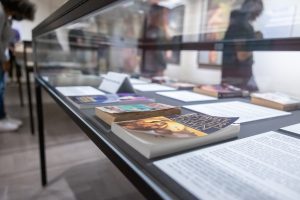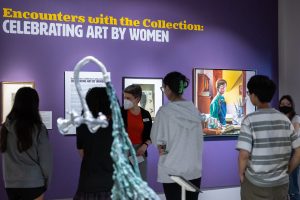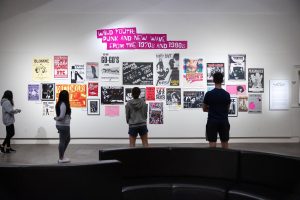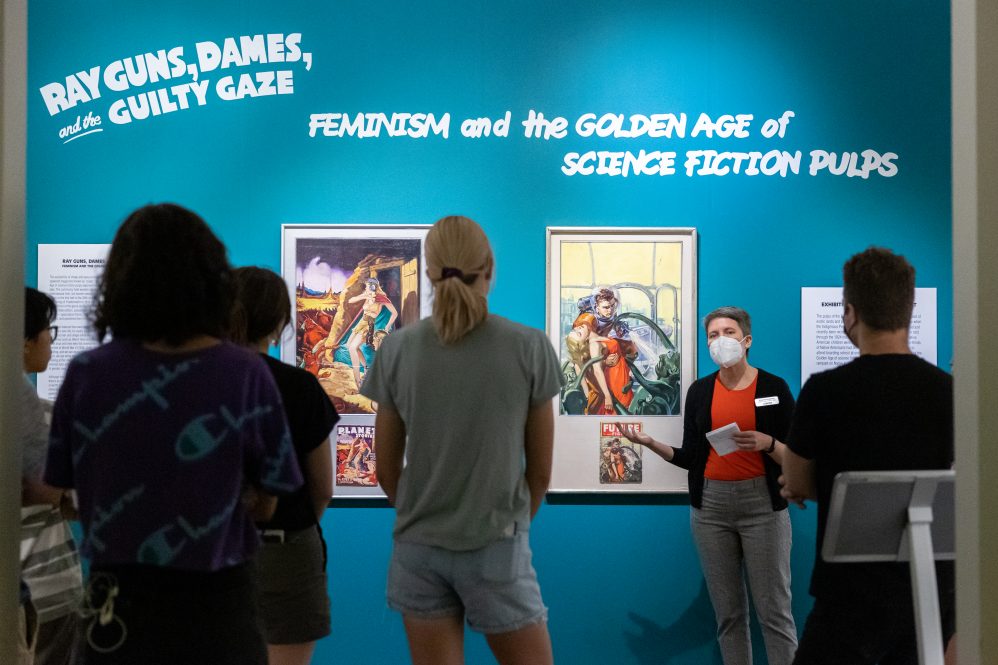This may sound like the start of a joke: what do a horse head, a pin-up girl, and the Sex Pistols have in common? But the answer isn’t necessarily funny, as the three new exhibitions at the William Benton Museum of Art illustrate the contributions of female artists and their struggle for equality and notice.
Executive Director Nancy Stula says the museum doesn’t usually tie together exhibitions with a similar theme, but the 50th anniversary of UConn’s Women’s Center gave enough reason to run the same string through three seemingly disparate shows:
“Encounters with the Collection: Celebrating Art by Women” in the Gilman Gallery, running through July 2024; “Ray Guns, Dames, and the Guilty Gaze: Feminism and the Golden Age of Science Fiction Pulps” in the Center Gallery, running through Dec. 18; and “Wild Youth: Punk and New Wave from the 1970s and 1980s” in the East Gallery, running through Oct. 16.
Beautiful Artistry, Ugly Message
“When isn’t it a good time for a feminist look at pulp science fiction,” asks UConn Women’s, Gender, and Sexuality Studies associate professor-in-residence Barbara Gurr. “The common wisdom is that science fiction has historically been predominantly white, male, straight, and cisgender. Really examining how and why that both is and isn’t true, and how it’s changed, is an incredibly fruitful way of examining our society.”
Gurr curated the pulp fiction exhibition with UConn illustration/animation associate professor Alison Paul who says she saw some of the work on display at the New Britain Museum of American Art – which loaned many of the pieces for the Benton show – and started thinking about ways to showcase the artwork “while not ignoring the inherent sexism, racism, and homophobia they often depict.”

After connecting with Gurr, who teaches a class on feminism and science fiction, the two spent the next year sifting through the Robert Lesser collection at the New Britain Museum and the Loftus Becker collection at Trinity College’s Watkinson Library.
“The more we worked with the material and did the research, the more we saw stories that we felt needed to be told,” Gurr says. “For example, we wanted to discuss Mary Shelley and ‘Frankenstein,’ but we didn’t know at first how exciting it would be to discuss C.L. Moore and ‘Shambleau.’ Learning more about the female writers and editors who worked behind the scenes, the ways that race has been both used and marginalized, considering the uses of the body in the illustrations, all these things told a story that became impossible to ignore.”
Take the work of illustrator Margaret Brundage, for example, identified in the exhibition as “The Queen of Pulp Pin-Up Art” and one of the only female illustrators working during the Golden Age of pulp. She published in “Weird Tales” for the first several years using only an initial for her first name, a common tactic for women in the early 1900s to hide their gender.
Paul and Gurr say that once her identity was revealed a frenzy ensued: She was illustrating partially nude women on magazine covers and to many that implied lesbianism.
“Examining pulp fiction from the Golden Age through a feminist lens really highlights some of the political and social issues both of that time – 1938 to 1950 – and of this time,” Gurr says. “Immigration, gender, settler colonialism, race, sexuality, nationalism, power, these were foundational to the telling and illustrating of science fiction 80 years ago.”
Paul notes that some of the imagery is graphic enough to startle visitors, so the pair posted a trigger warning at both entrances. They also included QR codes to some of the published works and included a case of contemporary science fiction from the 1970s to today, which provides more diversity and inclusiveness and serves as a “bit of a palette cleanser,” she says.
“Something we said a lot while curating this show is that the content isn’t easy, but it is important,” Paul says, adding that a Wikipedia Edit-a-thon on Nov. 2 will add entries or fill out stubs for many of the women in the exhibition. “We wanted to give viewers outlets for the thoughts and feelings that the show might bring up.”
Range of Female Contributions
Among the 45 pieces on display in the Gilman Gallery as part of “Encounters with the Collection,” there’s one that catches the eye of museum assistant curator Amanda Douberley every time she walks into the space.
“It’s an image with so many different layers, there are so many things you can think about,” Douberley says of Graciela Iturbide’s photograph, “Angel Woman, Sonoran Desert, Mexico.”
The black-and-white image of an Indigenous Seri woman in traditional dress carrying a circa-1979 boom box across the rough landscape of the Mexican desert is one that Douberley says is among Iturbide’s most famous and one she didn’t remember taking until she saw it on a contact sheet when putting together a book.
“I love talking with students about this photo. You can talk about the element of chance and surprise in everyday life and in different kinds of work. You can talk about discoveries,” she says. “There’s a lot packed into that photo.”
There’s a lot packed into the full exhibition, too.
“Encounters” highlights from the Benton’s holdings the range of contributions women have offered the art world from self-portraits to porcelain pot vases. A jersey-knit wrap dress from designer Diane von Furstenberg, a Red Cross World War I lithograph from Jessie Willcox Smith, and an oil on canvas from Marguerite Stuber Pearson featuring a woman arranging a vase of flowers add to the feminist theme that binds this exhibition to the museum’s other two.
Douberley, who curated the show, says she spent about a year working with undergraduate interns to go through the Benton’s collection of roughly 7,000 pieces to properly note which were created by women or someone who identified or identifies as female. The Benton’s databases didn’t record that information, and a year of research provided the missing parts of a piecemeal list.

“We paid attention to the balance of media,” she says of composing the show. “I wanted to make sure we had photos and paintings and posters. We’re also celebrating the Puerto Rican/Latin American Cultural Center’s 50th anniversary, so I wanted to make sure we had pieces to represent Puerto Rican and Latin American artists.”
Since the exhibition will be up for two years, some of the artwork done on paper – like photographs – will be changed out to preserve their life. However, visitors will see the Benton’s newest acquisition, its first since the pandemic, throughout the duration.
“Faucet with Horsehead” by Valerie Hegarty is one of the centerpieces of the exhibition, depicting a horsehead modeled after the confederate statue of Robert E. Lee coming out of a faucet suspended in mid-air. The work was made last year as part of Hegarty’s “The Covid Diary Series.”
“During lockdown, many artists, including Hegarty, didn’t have access to their studio space,” Douberley explains. “She spent a lot of time intensely journaling. The resulting sculpture series looks at the domestic environment and the effect COVID and concurrent social events had on the time period.”
The Robert E. Lee statue was removed from its foundation on Monument Avenue in Richmond, Virginia, in 2020 following the death of George Floyd. That came as people continued to wash their hands and sanitize their surroundings in the face of a deadly virus. During those months, bad news seemed to flood people’s homes like a gush from a faucet.
The sculpture might stand in contrast to the earliest piece in the exhibition from Anna Maria van Schurman, a Dutch woman who engraved a self-portrait in 1640 – or maybe not.
“Until the 19th century women were excluded, certainly from education in general, but also life-drawing sessions of nude models,” Douberley says. “Life drawing is the basis of history painting, which in the Euro-American tradition is one of the most important genres of painting. Because women weren’t allowed to learn how to paint the figure, they had to use themselves as models.”
Without training on how to paint human forms, women were excluded from high art – scenes from religion, portraiture, and landscapes – so they couldn’t compete with men who were given the proper training.
“There were some themes that I really wanted to pull out, and self-portraiture – and how it literally illustrates the sexism of the time period – is definitely one of them,” Douberley says.
Women of Punk
While an exhibition on punk rock might not overtly scream feminism, Stula says that in putting together the show with renowned punk collector and expert Andrew Krivine the two focused on the contributions of women to punk, including photographer Sheila Rock, who documented the punk scene in London in 1976 and 1977.
Large images of the band Subway Sect during a rehearsal, and The Clash with the Young Sinners adorn one section of the exhibition. There’s also a picture of Sid Vicious before his final performance in the U.K. as lead singer of the Vicious White Kids. All of it documents the punk scene and unique style that arose from it.
Stula said Rock gave to the Benton a flash drive with her photographs so they could be blown up to fill the large display walls in the gallery – thus making the pictures come to life.
Much of what punk is known for – aside from the music, of course – is the graphic design of its posters, flyers, fanzines and other materials, Stula says. No punk designer is more famous than Jamie Reid of the Suburban Press, who developed the graphic identity of the Sex Pistols.
Think of the famous image of a young Queen Elizabeth centered over the Union Jack, with the words “God Save the Queen” over her eyes and “Sex Pistols” over her mouth – that was Reid’s handiwork.

“We’re focusing on the graphic wealth that you find in punk,” Stula says. “In going through Andrew’s collection, I chose all the pieces in this show on their graphic interest and the way the graphic designers created the posters. He had other posters that were inside albums or just photographs of the bands and those, for the most part, I did not include. I really wanted this to be about graphic design.”
While a men’s suit might not be a traditional medium, Stula says she included it because a large element of punk is a “work-with-what-you-have” mentality – a la the Reid artwork for the Sex Pistols that lifts fonts and lettering from other sources – and fashion that borrowed oversized suits and skinny ties from a parent’s closet exemplifies that well.
“One of the reasons Andrew Krivine got into punk was because he was spending summers in England when he was 16, visiting family there, and his cousin John Krivine was the owner of Boy, a punk shop where you could buy clothing,” Stula says. “It was a hangout for the punk singers and was just down the street from a shop called SEX, which was owned by Vivienne Westwood and her boyfriend, Malcolm McLaren, who was manager of the Sex Pistols.”
The connections don’t stop there.
The manager of Boy, which originally was known as Acme Attractions, was Don Letts, who filmed footage of bands over 100 days for the documentary “The Punk Rock Movie,” a 1978 film being screened in one corner of the exhibition. Letts used a Super 8 camera that was gifted to him, Stula says, and sold his clothes for money to buy more film.
“Everything is intertwined with the music, the fashion, and these shops,” she says.
Intertwined with this exhibition is a companion show, “Days and Nights of Print and Punk,” at the Schimmelpfeng Gallery in the UConn Archives & Special Collections, running through Oct. 16. That exhibition, Stula says, looks at the local punk scene.
Punk grew in the 1970s among young adults who were “energetic and disillusioned” by the political and economic conditions in the U.S. and the U.K. at the time, Stula says: “They sought to rebel in their style of music, the way they dressed, and even the makeup they wore.
“It was all a part of a feeling of that particular decade,” she adds. “I’ve been thinking a lot about generations and what generation people belong to. This is certainly an example of a generation, or a segment of a generation, from the late ’70s to the early ’80s.”
Various events are being held in conjunction with each exhibition. Visit the Benton’s calendar of events for information.



